Method and system of threshold selection for reliable relay stations grouping for downlink transmission
a relay station and relay technology, applied in the field of data communication networks, can solve the problems of increasing the complexity and cost of the transceiver, the inability to use beamforming capability in laneman, and the difficulty of maintaining relaying schemes in practi
- Summary
- Abstract
- Description
- Claims
- Application Information
AI Technical Summary
Benefits of technology
Problems solved by technology
Method used
Image
Examples
Embodiment Construction
[0031]FIG. 1 shows a cooperative relay transmission scheme (more specifically, a cooperative multicast relay transmission scheme), according to the Copending Non-provisional application incorporated by reference above. Under this scheme, transmission between the BS and the MS can be separated into two parts—i.e., between the BS and the RSs (the “BS-RSs link”) and between RSs and MS (the “RSs-MS link”). The channel conditions in these two parts are characterized by their respective SNRs. Here, a pre-defined threshold value allows evaluation of the reliability of the BS-RSs link. If the number of reliable RSs is larger than this threshold value, the reliable RSs transmit the packet to the MS in a cooperative manner. According to this scheme, only reliable RSs transmit packets to the MS, while unreliable RSs remain passive.
[0032]According to one embodiment of the present invention, a threshold selection criterion is applied to form a reliable RSs group. A threshold value υ is selected ...
PUM
 Login to View More
Login to View More Abstract
Description
Claims
Application Information
 Login to View More
Login to View More - R&D
- Intellectual Property
- Life Sciences
- Materials
- Tech Scout
- Unparalleled Data Quality
- Higher Quality Content
- 60% Fewer Hallucinations
Browse by: Latest US Patents, China's latest patents, Technical Efficacy Thesaurus, Application Domain, Technology Topic, Popular Technical Reports.
© 2025 PatSnap. All rights reserved.Legal|Privacy policy|Modern Slavery Act Transparency Statement|Sitemap|About US| Contact US: help@patsnap.com



